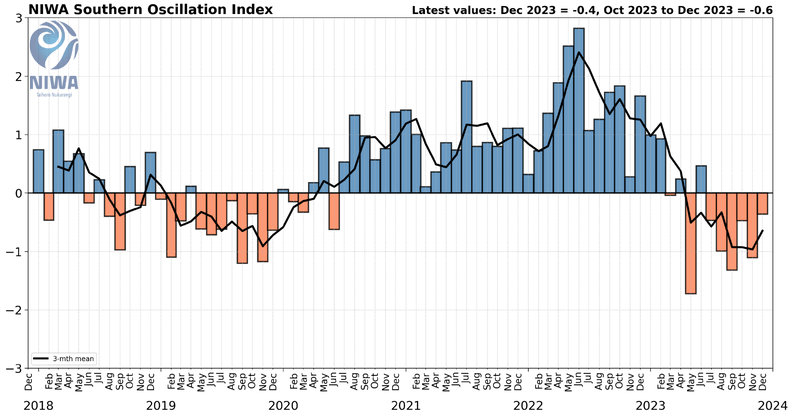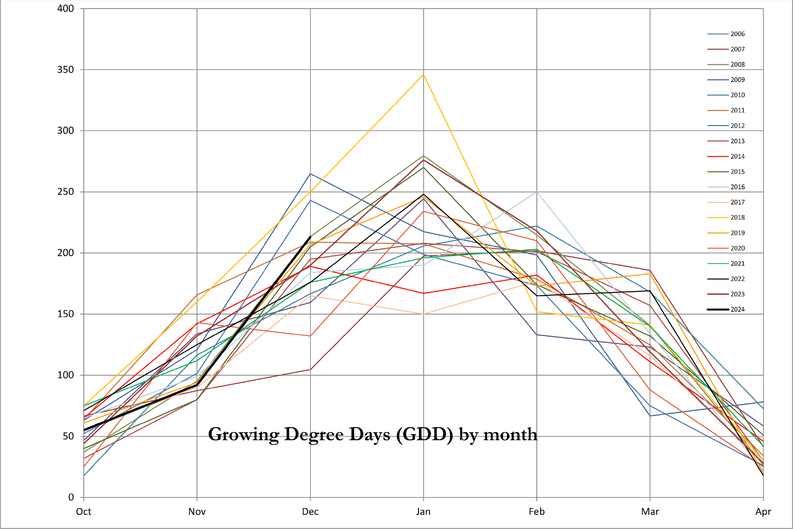The 1997–1998 El Niño was regarded as one of the most powerful El Niño–Southern Oscillation events in recorded history and we now know the 1998 vintage produced some of the greatest and longest lived Hawke’s Bay red wines.
NOAA (National Oceanic & Atmospheric Ass) states in a Dec 2023 blog, “There’s a 54% chance that this (2023/24) El Niño event will end up “historically strong”, potentially ranking in the top 5 on record.”
In this blog I breakdown what El Niño means for Grasshopper Rock and Central Otago and why it can matter or maybe not matter.
NIWA’s (National Institute of Water and Atmospheric Research) criteria for classifying an El Niño event were satisfied during September 2023. In particular, the Southern Oscillation Index was firmly in El Niño territory.

A strong El Niño can tilt the odds in favour of a particular outcome. The stronger the pattern the more likely the outcome will match weather forecast predictions. With this in mind let’s review NIWA’s predictions in relation to what has happened to date.
NIWA forecasts for two regions which include parts of Otago. One area includes east Otago, and the other area covers inland Otago. Grasshopper Rock in Alexandra is in the easternmost winegrowing sub-region of Otago and the weather can be more like east Otago than Cromwell/Gibbston/Wanaka which is clearly inland Otago.
El Niño brings more westerly weather. Anywhere from south-southwest to northwest with each direction bringing different outcomes. With Grasshopper Rock being one of the easternmost vineyard sites, we live in the shadow of the other sub-regions which are further west and closer to the Southern Alps.
Temperatures. NIWA predicted most likely above average for the east. The actual has been average or slightly above average. Although November was below average and December above average.
Rainfall. NIWA predicted below or near normal. Actual has been below average despite some high rainfall in the west about the Southern Alps.
Seasonal wind speeds. Expected stronger than normal. Actual has been higher than normal wind speeds from the south, west and northwest.
Soil moisture. NIWA predicted equal chance of near normal or below. Actual has been near normal or below.

As can be seen the chart above December 2023 (black line) is one of our five warmest Decembers. Only being topped by vintages 2006, 2012 and 2018, and equal to 2008. None of these years are associated with a strong El Nino event. 2018 vintage temperatures were extreme and initially a La Nina event. (See 2 minute NIWA video below)
What does it mean?
In November it was not looking like a “good” El Niño. In an El Niño early spring, strong southerly fronts can impact the region. In November 2023 we recorded 20 days of S to SW wind, six days when temperatures dropped to zero, numerous light snowfalls on the hills, and below average temperatures for the month. This was an ominous sign leading into flowering around week two of December.
Fortunately, temperatures in December were above average and rainfall below average. Rainfall for December was the lowest since December 2016. This makes for ideal flowering conditions and fruit set.
For the wider Central Otago winegrowing region, the strong cold fronts and snow on the hills in spring meant some isolated frost damage on early shoots, especially where it was difficult to combat due to the way the cold air moved, and frost fighting was impractical.
Is there a correlation between El Niño, La Niña and vintage quality?
I think not in Central Otago. There are simply too many weather and sub-regional variables. If I had a choice I would ask for a warm dry December for flowering and the odds for this in a strong El Niño are increased but a good flowering does not decide vintage character. Potential flowering and fruiting are influenced by the previous year’s weather and more importantly by temperatures in October and November leading into flowering.
Weather variables produce many outcomes that influence the final wine. These range from the obvious visible aspect of small bunches or large bunches, small berries or large berries, open bunches or closed bunches, berry size mix (known as hens and chicks or millerandage) to the not visible chemical variables due to sun exposure, wind, speed of ripening and temperatures during ripening as well as water stress and even autumn frost. There is a lot going on for the little Pinot Noir berry!
References:
NIWA: https://niwa.co.nz/climate/information-and-resources/elnino
NIWA Outlook: https://niwa.co.nz/climate/seasonal-climate-outlook/seasonal-climate-outlook-for-november-2023-january-2024
